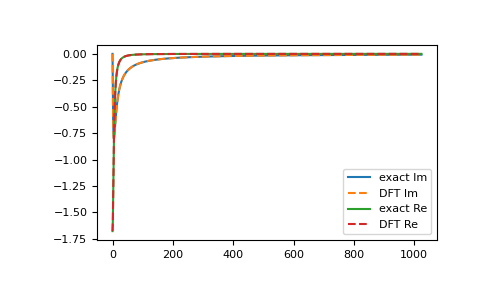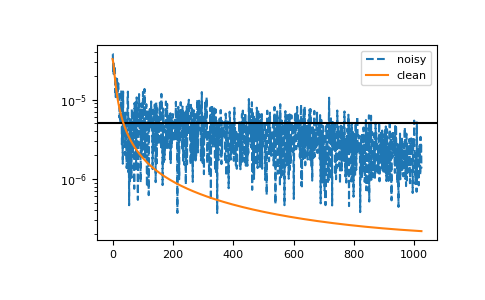gftool.fourier.tau2iv_ft_lin¶
-
gftool.fourier.tau2iv_ft_lin(gf_tau, beta)[source]¶ Fourier integration of the real Green’s function gf_tau.
Fourier transformation of a bosonic imaginary-time Green’s function to Matsubara domain. We assume a real Green’s function gf_tau, which is the case for commutator Green’s functions \(G_{AB}(τ) = ⟨A(τ)B⟩\) with \(A = B^†\). The Fourier transform gf_iv is then Hermitian. Filon’s method is used to calculated the Fourier integral
\[G^n = ∫_{0}^{β}dτ G(τ) e^{iν_n τ},\]\(G(τ)\) is approximated by a linear spline. A linear approximation was chosen to be able to integrate noisy functions. Information on oscillatory integrations can be found e.g. in [filon1930] and [iserles2006].
- Parameters
- gf_tau(…, N_tau) float np.ndarray
The Green’s function at imaginary times \(τ \in [0, β]\).
- betafloat
The inverse temperature \(beta = 1/k_B T\).
- Returns
- gf_iv(…, (N_iv + 1)/2) float np.ndarray
The Fourier transform of gf_tau for non-negative bosonic Matsubara frequencies \(iν_n\).
See also
tau2iv_dftPlain implementation using Riemann sum.
References
- filon1930
Filon, L. N. G. III.—On a Quadrature Formula for Trigonometric Integrals. Proc. Roy. Soc. Edinburgh 49, 38–47 (1930). https://doi.org/10.1017/S0370164600026262
- iserles2006
Iserles, A., Nørsett, S. P. & Olver, S. Highly Oscillatory Quadrature: The Story so Far. in Numerical Mathematics and Advanced Applications (eds. de Castro, A. B., Gómez, D., Quintela, P. & Salgado, P.) 97–118 (Springer, 2006). https://doi.org/10.1007/978-3-540-34288-5_6 http://www.sam.math.ethz.ch/~hiptmair/Seminars/OSCINT/INO06.pdf
Examples
>>> BETA = 50 >>> tau = np.linspace(0, BETA, num=2049, endpoint=True) >>> ivs = gt.matsubara_frequencies_b(range((tau.size+1)//2), beta=BETA)
>>> poles, weights = np.random.random(10), np.random.random(10) >>> weights = weights/np.sum(weights) >>> gf_tau = gt.pole_gf_tau_b(tau, poles=poles, weights=weights, beta=BETA) >>> gf_ft_lin = gt.fourier.tau2iv_ft_lin(gf_tau, beta=BETA) >>> gf_tau.size, gf_ft_lin.size (2049, 1025) >>> gf_iv = gt.pole_gf_z(ivs, poles=poles, weights=weights)
>>> import matplotlib.pyplot as plt >>> __ = plt.plot(gf_iv.imag, label='exact Im') >>> __ = plt.plot(gf_ft_lin.imag, '--', label='DFT Im') >>> __ = plt.plot(gf_iv.real, label='exact Re') >>> __ = plt.plot(gf_ft_lin.real, '--', label='DFT Re') >>> __ = plt.legend() >>> plt.show()

>>> __ = plt.title('Error decreasing with frequency') >>> __ = plt.plot(abs(gf_iv - gf_ft_lin), label='FT_lin') >>> gf_dft = gt.fourier.tau2iv_dft(gf_tau, beta=BETA) >>> __ = plt.plot(abs(gf_iv - gf_dft), '--', label='DFT') >>> __ = plt.legend() >>> plt.yscale('log') >>> plt.show()

The method is resistant against noise:
>>> magnitude = 5e-6 >>> noise = np.random.normal(scale=magnitude, size=gf_tau.size) >>> gf_ft_noisy = gt.fourier.tau2iv_ft_lin(gf_tau + noise, beta=BETA) >>> __ = plt.plot(abs(gf_iv - gf_ft_noisy), '--', label='noisy') >>> __ = plt.axhline(magnitude, color='black') >>> __ = plt.plot(abs(gf_iv - gf_ft_lin), label='clean') >>> __ = plt.legend() >>> plt.yscale('log') >>> plt.show()
